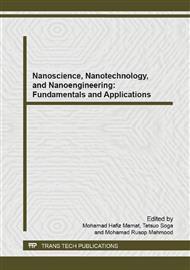p.35
p.40
p.45
p.50
p.55
p.60
p.64
p.69
p.73
The Synthesis of Graphene Oxide via Electrochemical Exfoliation Method
Abstract:
In this study, electrochemical exfoliation method was adopted in the production of graphene oxide (GO). The electrolyte used was sodium dodecyl sulphate (SDS) aqueous solution at various concentrations from 0.001 to 1.0 M. The effect of SDS concentrations on the morphology of GO samples were characterized using field emission scanning electron microscopy (FESEM), energy dispersive X-ray, micro-Raman and UV-Vis spectroscopy. As evident by the FESEM analysis, the concentration of SDS does give effect to the GO obtained in this study. The lowest GO production is given by the lowest concentration of SDS used which is 0.001 M. However, in term of ID/IG ratio, the sample prepared at 0.001 M has the lowest value (0.33) as compared to the sample prepared with highest SDS concentration of 1.0 M (ID/IG ~1.12). Meanwhile, the presence of absorbance peaks in the range of 224-237 nm from UV-Vis spectra analysis were seen for the whole samples and this indicate the formation of GO.
Info:
Periodical:
Pages:
55-59
Citation:
Online since:
June 2015
Price:
Сopyright:
© 2015 Trans Tech Publications Ltd. All Rights Reserved
Share:
Citation:


